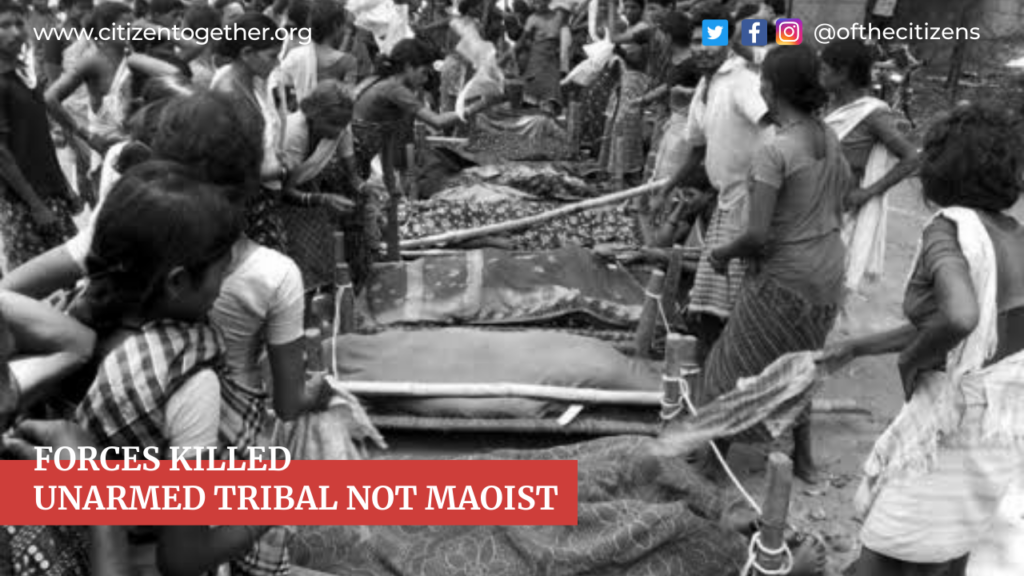Eight years after security personnel gunned down eight persons, including four minors, in Edesmetta in Bijapur district of Chhattisgarh, a judicial inquiry report, submitted to the state cabinet Wednesday 08th September, concluded that none of those killed were Maoists, as was alleged at the time of the incident.
The report by Justice V K Agarwal, a retired judge of the Madhya Pradesh High Court who was asked to inquire into the incident, said the security personnel “may have opened fire in panic”.
Calling the incident “a mistake” thrice in the report, Justice Agarwal said the tribal killed were unarmed and died in gunfire of 44 rounds, 18 of which were fired by a single constable of the CoBRA unit of the CRPF.
A separate inquiry into the incident is being conducted by the CBI following a Supreme Court order in May 2019.
The Edesmetta incident took place on the night of May 17-18, 2013 – a week before the Jhiram Ghati incident in Sukma district in which 27 people, including top state Congress leaders, were killed in a Maoist attack. While police had denied the presence then of Maoists in Edesmetta, the CoBRA claimed busting a Maoist hideout.
Edesmetta, 17 km from the nearest road and more than 40 km from the district headquarters, falls under Gangaloor police station in Bijapur district, one of the worst affected by Left Wing Extremism in the state. There is still no road to the village where, according to the judicial report, 25-30 people had gathered to celebrate Beej Pandum, a tribal festival to worship new life in the form of seeds, on the night of May 17 in 2013 when a 1000-strong security force showed up.
While security forces had said then that they came under fire and had retaliated, the report stated that there was no threat-to-life to security personnel who had not followed the norms of a marching operation.
The report, in Hindi, said the incident of firing seemed to be a result of “galat dhaarna, ghabrahat ki pratikriya” (wrong assumption, nervous reaction).
“If the security forces were given enough gadgets for self-defence, if they had better intelligence from the ground and had they been careful, the incident could have been avoided,” it stated.
In the summary, the report stated: “Security forces were not equipped with enough devices for self-defence, there was shortage of intelligence, which is why in self-defence and ‘in panic’, they fired.”
Observing that there was no cross-fire, the report said CoBRA Constable Dev Prakash died due to friendly-fire and not because of the Maoists.
The report stated that while two “bharmar” rifles were seized at the spot, they were not responsible for the bullet wound in Prakash’s head.
This corroborates with what the villagers had said after the incident. Karam Manglu had said then: “While firing was on, we suddenly heard them shouting, ‘firing roko, humare ek aadmi ko goli lagi hai (stop firing, one of our men has been shot)’.”
The commission found several shortcomings in the work of the security force. Calling the seizure of the two “bharmar” guns “sandigdh” (suspicious) and “avishwasniya” (unbelievable), the report pulled up officers for not having any description of the items in the seizure report. It said no items from the field were sent to forensic labs.
“There was no strong intelligence behind the operation. None of the gathered people had weapons, nor were they members of the Maoist organisation,” the report stated.
It encouraged use of drones and unmanned gadgets to avoid such incidents in future.
The report was approved by the cabinet, unlike the commission’s earlier report on the Sarkeguda encounter.
As in Edesmetta, people of Sarkeguda had gathered for the Beej Pandum celebrations in June 2012. Security forces had gunned down 17 people, including minors. The Sarkeguda report by Justice Agarwal, which had also indicted the security personnel, is still pending with the state law department.
c. The Indian Express



